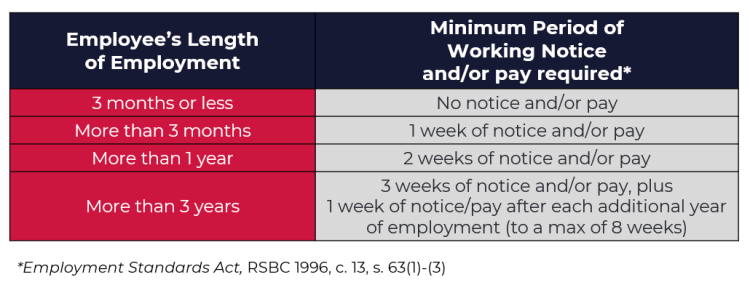Considering downsizing? Here is what British Columbia employers need to know
In times of economic uncertainty, employers in British Columbia may consider downsizing as a way to manage costs and mitigate risk.

Authors: Graham Christie, Mariana Olivo de Cerqueira
In times of economic uncertainty, employers in British Columbia may consider downsizing as a way to manage costs and mitigate risk. While general principles around employment standards apply, this blog post focuses on key legal considerations specific to British Columbia’s employers, including layoff definitions, notice requirements, union implications, potential termination claims and special rules for foreign workers.
What is considered a layoff in British Columbia?
In British Columbia, a temporary layoff occurs when an employee receives little or no work, but with the intention that they will be recalled to their regular duties.
An employee is considered to be on layoff if their earnings drop below 50% of their usual weekly wages, based on an average of the last eight weeks worked. If there is no plan to reinstate the employee, the layoff is treated as a termination.
During a valid temporary layoff, the employment relationship remains intact, and the employee continues to be entitled to benefits, vacation accrual and statutory leaves.
What are the individual notice requirements in British Columbia?
The amount of notice that an employee is entitled to depends on how long they have been employed with the organization.
To meet this obligation, employers may provide written notice specifying the employee’s last day of work. However, during the notice period, the employee must be actively available to work and earn wages.
An employer cannot issue notice if the employee is:
- On vacation;
- On a leave of absence;
- On a temporary layoff;
- Involved in a strike or lockout; or
- Unable to work due to medical reasons.
In these situations, the employer must wait until the employee returns to work to give notice.
Alternatively, if providing notice isn’t feasible (e.g. due to an ongoing leave), the employer can instead offer pay in lieu of notice.
If an employee continues to work beyond the end of the notice period, the notice becomes invalid. At that point, the employment relationship continues, and the employer would be required to issue a new notice or provide compensation to end the employment.
Once notice has been issued, employers cannot change any fundamental terms of employment – such as hours or wages – without the employee’s written consent.
The notice requirements are as follows:

Employees may be entitled to additional notice or pay in lieu of notice pursuant to an employment contract, employer policy or collective bargaining agreement.
What are the group notice requirements in British Columbia?
In addition to individual notice periods, employers are required to provide greater notice or pay in lieu of notice when terminating the employment of 50 or more employees within a two-month period.
The minimum notice for a group termination is as follows:

In addition to notifying affected employees, employers must also deliver written notice to:
- Any trade union certified to represent, or recognized by the employer as the bargaining agent of, any affected employees;
- The minister.
This notice should clearly set out:
- How many employees are affected;
- The anticipated termination date(s); and
- The reasons for the group termination.
If the required group notice is not provided, the employer must provide termination pay in lieu of notice. If the length of notice given is shorter than required, the employer must make up the difference with termination pay. Employers also have the option to provide a combination of written notice and termination pay to meet their obligations.
Please note that group termination notice and compensation are in addition to the individual notice or termination pay that employees are otherwise entitled to – whether outlined in an employment contract or a collective agreement.
For example, if a non-unionized employee is entitled to three weeks of individual notice based on their length of service, and the group termination requires eight weeks of group notice, the employee would be entitled to a total of 11 weeks’ notice or pay, or a combination of both.
Are layoffs different for unionized workplaces?
Layoffs in unionized workplaces are generally governed by the collective agreement, which may set out specific procedures, notice requirements and conditions for layoffs. Employers should carefully review the terms of the agreement to ensure compliance.
In unionized workplaces, employment-related disputes arising from the layoff process are typically addressed through the grievance procedure set out in the collective agreement. As such, any disputes about how layoff provisions apply in a unionized context must be resolved through the grievance procedure, not through the enforcement provisions of the Employment Standards Act, RSBC 1996, c. 13
Could employees claim their employment is terminated?
Employees who are placed on layoff may argue that their employment has effectively been terminated, particularly if there is no clear expectation of recall. In such cases, they may seek compensation based on their contractual or common law entitlements to reasonable notice. Whether a layoff amounts to a termination will depend on the specific facts of each situation and may require legal analysis on a case-by-case basis.
Are there additional considerations required for foreign workers?
Employers should be aware that additional obligations may apply when a group termination involves temporary foreign workers, including requirements under the Temporary Foreign Worker Protection Act [SBC 2018, c. 45] and other applicable regulations.
While the specifics of these obligations are beyond the scope of this overview, future blog posts will explore them in more detail. In the meantime, employers with questions about terminating temporary foreign workers are encouraged to contact our immigration team for guidance.
If you have questions about the legal risks and strategies to downsizing your workforce, please contact one of MLT Aikins labour and employment lawyers.
Read other articles in this series:
Note: This article is of a general nature only and is not exhaustive of all possible legal rights or remedies. In addition, laws may change over time and should be interpreted only in the context of particular circumstances such that these materials are not intended to be relied upon or taken as legal advice or opinion. Readers should consult a legal professional for specific advice in any particular situation.



